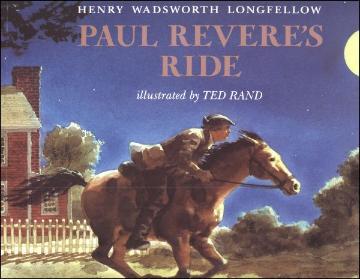
Paul Revere's Ride
Read Aloud Book: Paul Revere’s Ride
Story: Henry Wadsworth Longfellow
Illustration: Ted Rand
ISBN-13: 978-0140556124
C3 Framework Key term: Event: An occasion, occurrence, or incident that takes place in the past. Events can be of various lengths.
Handouts
Paul Revere's Ride by Henry Wadsworth Longfellow (PDF version only)
Download and Print the PDF
Synopsis
Paul Revere’s Ride tells the story of Paul Revere and his historic ride to warn the town that the British soldiers were coming. It details Revere making the plan with the other soldier and continues through his ride and the resulting interaction between the British and American soldiers. The book is written in a poem-style with a rhyme scheme.
Discussion
Contextualize (show the timeline of the American Revolutionary War): Paul Revere’s Ride was on April 18, 1775. Two months later, the Congress appointed George Washington commander-in-chief of Continental Army. In multiple points in time, the revolutionary war nearly failed. The first time was the Battles of Lexington and Concord, which were saved by the warning of the midnight massagers. Although the British soldiers outnumbered the patriot militia, the resistance of the Patriots surprised them and forced the British to retreat. Ask: With limited weapons and a shortage of troops, how did the determination and courage of the Patriots win against the well-trained British soldiers? Can you think of others times in history when a small army won against a larger army because of the ideals it fought for?
Ethics Connections
Distribute copies of the poem, Paul Revere’s Ride, written by Henry Wadsworth Longfellow, and first published in The Atlantic in 1861. Say: The poet used the famous story from the Revolutionary War to promote the moral courage of people in the North on the eve of the Civil War. Mention that the poet did not intend to convey a historically accurate account of the event but to spur reflections about values. Say: The poet recognized that people hesitate to do the right thing when risk is involved. Moral courage or its absence can make the difference between moral attitudes and moral action. In groups or pairs, highlight the lines that demonstrate the Longfellow’s focus on courage in the face of danger. Make a list of all the risks taken by Paul Revere. Ask students to read aloud their lists and write the merged list of risks on the board. The list might include Injury, death or imprisonment; revealing confidential information if captured; losing his business; putting his wife, children, and other family members at risk; losing his good reputation if the news turned out false.
Challenge Activity
Say: Multiple forms of oppression led to the Revolutionary War. One was a violation of people’s right to privacy. In 1765, the acting Secretary of State issued a warrant to break into the private home of John Entick in search for private papers. In court, the judge ruled that this search, although under warrant, was unlawful and unethical. The Founding Fathers ensured the secure people’s right for privacy in the Fourth Amendment, including “The right of the people to be secure in their persons, houses, papers, and effects, against unreasonable searches and seizures.” Write a paragraph that discusses how lack of privacy threatens people’s well-being, ability to defend themselves against unethical actions and the functioning of a flourishing society.
Fun Activity
Say: Write a short poem about an event in the American Revolutionary War. In your poem, link the event to moral courage needed for a current event, debate, movement, or public concern.